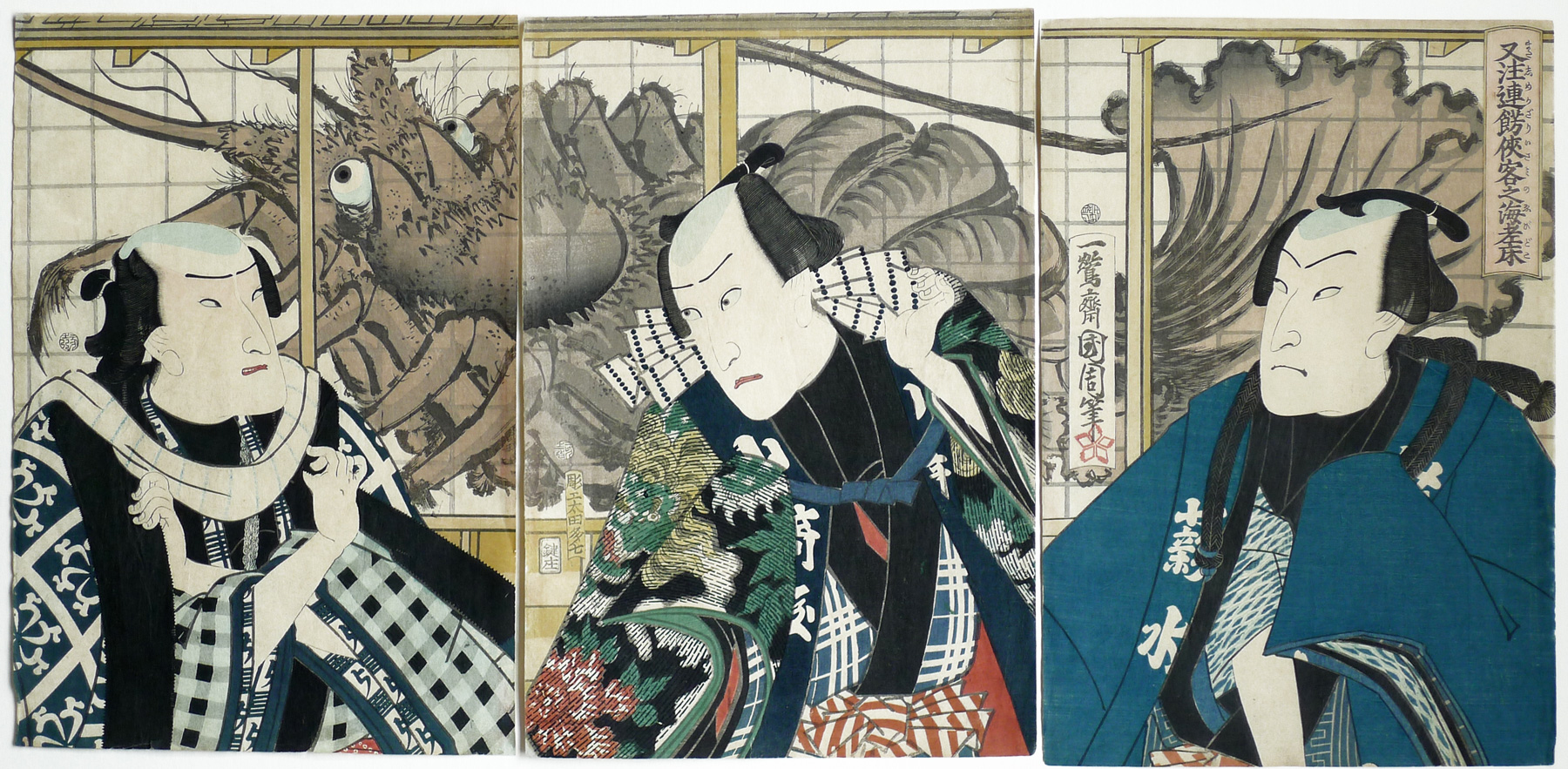About This Print
Three actors stand in front of a barbershop’s shoji decorated with a painting of a giant shrimp (ebi). No specific play is referenced in the print, perhaps making it an advertisement for the Shrimp Barbershop. This is not as strange as it seems, as kabuki stars spent hours in the barbershop having their sakayaki (the shaved part of the forehead) looked after. Perhaps the Shrimp Barbershop business card read “Hairstylists to the Stars."I have been given two plausible translations of the print's title cartouche "Mata shime kazari isami no ebi doko" (又注連餝俠客之海老床). One supplied by Sato-san via the Ukiyoe Q&A website is "Another Story of Chivalrous Guys (otokodate) at Ebidoko Barber Shop in the New Year Season" and the other, supplied by Maribeth Graybill, Curator of Asian Art at the Portland Art Museum, is "Another Garland of Swashbuckling Heroes of the Shrimp Barbershop."
The actors pictured, while not named in cartouches on the print, would have been recognizable to the public by the patterns and the partial letters of their stage names visible on their garments. Sato-san has identified them (left to right) as: Ichimura Uzaemon XIII or, possibly, XIV, according to the pattern of his clothes; Kawarazaki Gonjûrô (Gonjyuro) by the half-hidden stage name on his collar1 and Bando Shinsui2 by the two kanji characters 薪水 (Shinsui) on his robe.
1 My note: The cross-hatched pattern on Gonjurou's inner robe is the pattern of his actor's mon.
2 However, the National Museum of Japanese History database identifies the actor as Bando Hikosaburo V 坂東彦三郎5
The Actors Pictured
For background on the actors Ichimura Uzaemon XIII and XIV, Kawarazaki Gonjûrô, and Bando Shinsui IV see their respective entries in the article The Kabuki Actor on this site.Wall Card
Another Garland of Swashbuckling Heroes of the ShrimpBarbershop, 1863
(Mata shime kazariisami no ebi doko 又注連餝俠客之海老床 )
ToyoharaKunichika (1835–1900)
Whereveryou go, barbershop or bathhouse, whatever people are discussing, whetherloyalty, chastity, or filial devotion, every example is kabuki.1
While not explicitly identified, the actors pictured would have been recognizable to kabuki fans of late-Edo by the patterns and the partial letters of their stage names visible on their garments. Ichimura Uzaemon XIII (or XIV), on the left, can be recognized by the pattern on his kimono; Kawarazaki Gonjûrô, in the center, by his half-hidden stage name on his collar and the cross-hatching on his inner robe and, on the right, Bando Shinsui by the two kanji characters 薪水 (Shinsui) on his robe. The reference in the title to shime kazari (straw garlands) and a December 1863 publishing date, link this print to the New Year.The actors stand in front of a barbershop’s shoji decorated with a painting of a giant shrimp (ebi). No specific play is referenced in the print, perhaps making it an advertisement for the Shrimp Barbershop. This is not as strange as it seems, as kabuki stars spent hours in the barbershop having their sakayaki looked after. Perhaps the Shrimp Barbershop business card read “Hairstylists to the Stars.”
1 The Theatrical World of Osaka Prints, Roger S. Keyes and Keiko Mizushima, David R. Godine in association with Philadelphia Museum of Art, 1973, p. 40.Print Details
| IHL Catalog | #551 |
| Title (Description) | Mata shime kazari isami no ebi doko 又注連餝俠客之海老床 Another Garland of Swashbuckling Heroes of the Shrimp Barbershop |
| Artist | Toyohara Kunichika (1835–1900) |
| Signature | Ichiosai Kunichika hitsu |
| Seal | unidentified artist seal beneath signature  |
| Publication Date | 1863 (Bunkyô 3), 12th month |
| Publisher |  |
| Carver | |
| Impression | excellent |
| Colors | excellent |
| Condition | excellent - light thinning and several small repairs from verso at edge |
| Genre | ukiyo-e; yakusha-e |
| Miscellaneous | |
| Format | vertical oban triptych |
| H x W Paper | 14 1/8 x 9 5/8 in. (35.9 x 24.4 cm) each sheet |
| H x W Image | 14 1/8 x 9 5/8 in. (35.9 x 24.4 cm) each sheet |
| Literature | Decadence and Dissolution: Tattoo and Kabuki Art by Kunichika, Ukiyoe-Master Series: Volume Four, Jack Hunter, ed., Solar Books, 2012, p. 150. |
| Collections This Print | National Museum of Japanese History H-22-1-18-68 (right panel only) |


